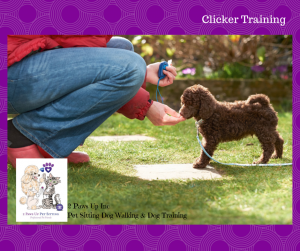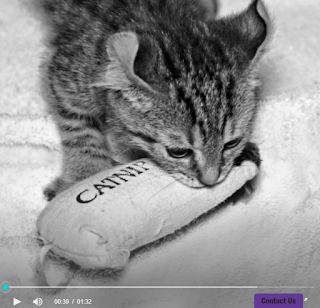Do You Use Clicker Training? Why?
As I’ve spent
more and more time researching and learning about pet care and behaviors, I’ve
become interested in the various methods and camps for pet training. What
methods work best? How do they work in shaping a pet’s behaviors and actions?
How are they taught? Today I’d like to focus on clicker training, which can be
used to train a wide variety of animals. Most often we see it used for training
dogs but it can also be used for horses, cats, birds, and plenty of other
animals.
Clicker as a tool vs. Clicker as training
First, let’s make a distinction. There’s the actual clicker tool. Then there’s clicker training, which is the overall method for marking and reinforcing positive behaviors. You can do clicker, or marker, training without the actual clicker. On the flip side, simply having a clicker doesn’t mean that you’re automatically doing clicker training.
The idea behind the method
Next, let’s talk method. The basic idea behind clicker training is to mark good or desirable behaviors and reinforce them so that the pet will perform them voluntarily in order to receive a reward. The method for marking these behaviors is a very succinct audio cue, a click, which sounds at the exact moment that the pet is performing the desired behavior. The click on the execution of the desired behavior is immediately followed with a reward. The pet is able to quickly learn that the actions that you click on are the ones that result in a positive experience, usually a treat but possibly also play time or other rewards.
Different for everyone
Within the clicker training method there is a variety of approaches for training, and these must be tailored further to serve individual trainers and pets. For example, the actual clicker might not be the tool of choice if the pet doesn’t react well to the sound. That’s not a problem. The marker tool just needs to be a consistent sound, visual cue, or other unique, sensory interaction. The reinforcement must also be specific to each pet. Most often the reward is a small treat but it can also be time with a toy, praise, petting or scratching, or whatever else motivates your pet and keeps their attention. Just know that in clicker training, especially early on, rewards will be given very often in order to establish the connection between the click and the positive reinforcement. That’s why many trainers opt for small snacks, because they can be given one piece at a time and, by the end, you haven’t over fed your pet.
Starting points: Loading the clicker or leading and clicking
Right from the start, the clicker training method diverges into two approaches. You can either teach your pet that the click means “treats” before you ever get them to perform, or you can lead them through the performance of behaviors (like sitting and lying down) and introduce the click when they’ve done what you wanted them to do.
First, loading the clicker: This method is a good way to ease in to clicker training, and it may be especially helpful when working with young pets. Loading the clicker means that you’re simply loading the click sound with meaning for your pet. In other words, click means treats. Start by getting your pet in a room with relatively few distractions. Come prepared with the clicker and plenty of treats. Click and then immediately give your pet a treat. Repeat this until your pet learns to expect a treat when it hears the click. This process may need to be repeated and reinforced over a few days. You can begin clicking and rewarding in different places so that your pet learns to recognize the click in any environment. Once your pet has learned to associate the click with a positive experience, begin teaching your pet the behaviors you want it to learn. By clicking on the execution of that behavior (shaking paws, sitting, etc.) you are marking that action a good and immediately rewarding it. Your pet will be more inclined to perform those same actions in the future.
The other option for beginning clicker training is to jump right in by teaching your pet positive behaviors and clicking on them. The process of luring and clicking can work like this: if you want your pet to learn to lie down on command, use a treat to lure them low to the ground. As soon at their belly touches the floor, click and give the reward. Repeat until your pet recognizes that the treat only comes after the click and the click comes when their belly hits the floor.
For either method, once you’ve marked the good behaviors, you take the next step by creating a cue to tell your pet what you’d like them to do. This can be a hand signal or word that indicates ideas like sit, stay, lie down, roll over, etc.
Remember that this is just the very beginning of how clicker training works. If this sounds like the training model for you, keep reading and researching to find more information about this method.
Clicker as a tool vs. Clicker as training
First, let’s make a distinction. There’s the actual clicker tool. Then there’s clicker training, which is the overall method for marking and reinforcing positive behaviors. You can do clicker, or marker, training without the actual clicker. On the flip side, simply having a clicker doesn’t mean that you’re automatically doing clicker training.
The idea behind the method
Next, let’s talk method. The basic idea behind clicker training is to mark good or desirable behaviors and reinforce them so that the pet will perform them voluntarily in order to receive a reward. The method for marking these behaviors is a very succinct audio cue, a click, which sounds at the exact moment that the pet is performing the desired behavior. The click on the execution of the desired behavior is immediately followed with a reward. The pet is able to quickly learn that the actions that you click on are the ones that result in a positive experience, usually a treat but possibly also play time or other rewards.
Different for everyone
Within the clicker training method there is a variety of approaches for training, and these must be tailored further to serve individual trainers and pets. For example, the actual clicker might not be the tool of choice if the pet doesn’t react well to the sound. That’s not a problem. The marker tool just needs to be a consistent sound, visual cue, or other unique, sensory interaction. The reinforcement must also be specific to each pet. Most often the reward is a small treat but it can also be time with a toy, praise, petting or scratching, or whatever else motivates your pet and keeps their attention. Just know that in clicker training, especially early on, rewards will be given very often in order to establish the connection between the click and the positive reinforcement. That’s why many trainers opt for small snacks, because they can be given one piece at a time and, by the end, you haven’t over fed your pet.
Starting points: Loading the clicker or leading and clicking
Right from the start, the clicker training method diverges into two approaches. You can either teach your pet that the click means “treats” before you ever get them to perform, or you can lead them through the performance of behaviors (like sitting and lying down) and introduce the click when they’ve done what you wanted them to do.
First, loading the clicker: This method is a good way to ease in to clicker training, and it may be especially helpful when working with young pets. Loading the clicker means that you’re simply loading the click sound with meaning for your pet. In other words, click means treats. Start by getting your pet in a room with relatively few distractions. Come prepared with the clicker and plenty of treats. Click and then immediately give your pet a treat. Repeat this until your pet learns to expect a treat when it hears the click. This process may need to be repeated and reinforced over a few days. You can begin clicking and rewarding in different places so that your pet learns to recognize the click in any environment. Once your pet has learned to associate the click with a positive experience, begin teaching your pet the behaviors you want it to learn. By clicking on the execution of that behavior (shaking paws, sitting, etc.) you are marking that action a good and immediately rewarding it. Your pet will be more inclined to perform those same actions in the future.
The other option for beginning clicker training is to jump right in by teaching your pet positive behaviors and clicking on them. The process of luring and clicking can work like this: if you want your pet to learn to lie down on command, use a treat to lure them low to the ground. As soon at their belly touches the floor, click and give the reward. Repeat until your pet recognizes that the treat only comes after the click and the click comes when their belly hits the floor.
For either method, once you’ve marked the good behaviors, you take the next step by creating a cue to tell your pet what you’d like them to do. This can be a hand signal or word that indicates ideas like sit, stay, lie down, roll over, etc.
Remember that this is just the very beginning of how clicker training works. If this sounds like the training model for you, keep reading and researching to find more information about this method.
See more at- http://www.2pawsupinc.com




Comments
Post a Comment